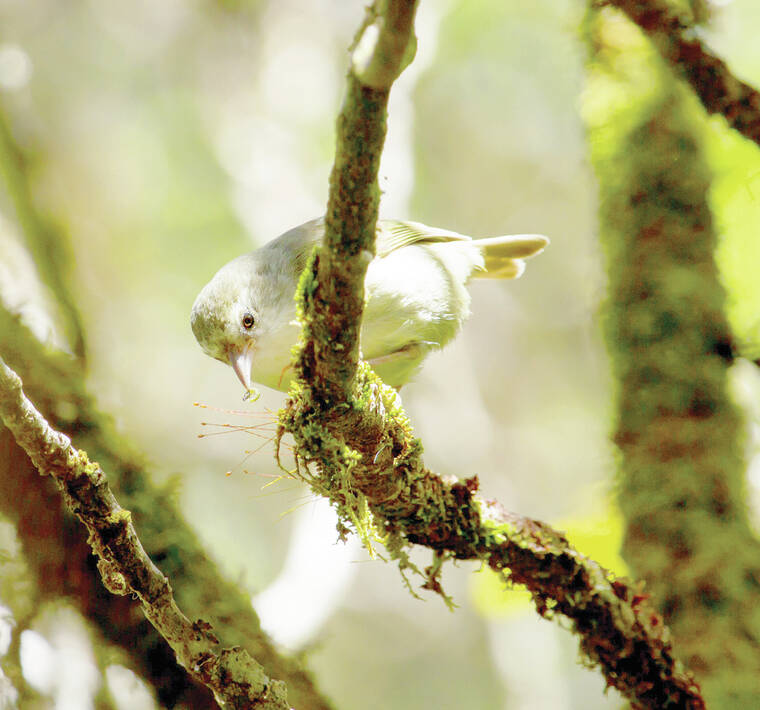LIHUE — The U.S. Fish and Wildlife Service (USFWS) and Department of Land and Natural Resources Division of Forestry and Wildlife (DOFAW) released Friday a draft environmental assessment for the use of biological control measures on Kaua‘i in an effort to protect the island’s endangered native forest birds from extinction.
Two honeycreeper species only found on Kaua‘i (‘akeke‘e and ‘akikiki) are in danger of extinction in as little as one to two years, as several additional honeycreepers face extinction in the near future, according to the Department of the Interior.
Additionally, a University of Hawai‘i report estimated that only 45 ‘akikiki existed in the wild as of 2021, and anticipated the bird would most likely face extinction sometime this year — a sentiment echoed by Kaua‘i’s conservationist groups, who have watched its numbers dwindle firsthand.
“Our field teams are reporting that ‘akikiki have almost disappeared from their habitats in the Alaka‘i Plateau,” said DOFAW administrator David Smith. “They are working very hard to collect eggs and adult birds from the field season, but between avian malaria and predation from rats, they are not having much success and believe the end is near for this honeycreeper species in the wild.”
Invasive southern house mosquitoes carrying avian malaria pose the greatest existential threat to native honeycreepers, according to the Department of the Interior. Because the honeycreepers have only recently come in contact with the disease, evolution has provided the birds little to no immunity against it, resulting in high mortality rates when infected. Once found across the island, Kaua‘i’s honeycreepers are now only found at higher elevations, where it’s too cold for the mosquitoes to survive.
But as climate change increases air temperatures, mosquitoes have successfully crept into much of what little safe habitat is left.
“The mosquitoes are marching farther and farther uphill, and the birds are basically running out of mountains,” said Bob Reed, deputy director at the U.S. Geological Survey’s Pacific Island Ecosystems Research Center.
“For Kaua‘i and Maui in particular, there’s limited habitat left that’s mosquito-free, and so some of these birds that are very, very sensitive to avian malaria are on the verge of blinking out.”
As the mosquitoes’ onslaught leaves Hawai‘i’s honeycreepers out of room and out of time, the Department of the Interior has begun fighting back with a multiagency, multiyear, multimillion-dollar counteroffensive.
Announced in December 2022, the plan includes shorter-term strategies, such as captive care and relocation to neighbor islands in order to protect forest birds facing imminent extinction.
However, to foster long-term survival on the birds’ native islands, the plan also includes a biological control program intended to cull the mosquito’s numbers using a bacterium called Wolbachia.
While the bacterium has no impact on humans, its strong sterilizing effect on mosquitoes makes it an optimal tool for limiting the insect’s spread across Hawai‘i, the department has said.
The program, if implemented, would see USFWS and DLNR teams release male mosquitoes carrying Wolbachia across approximately 59,204 acres of forest reserves, state parks and private lands in Koke‘e and the Alaka‘i Plateau.
Once released, the mosquitoes would mate with the sites’ female mosquitoes, spreading the Wolbachia bacterium and rendering the females infertile. With fewer successful births, the mosquito population would be suppressed over time.
The Environmental Protection Agency authorized in April emergency exemption for use of Wolbachia in Kaua‘i, Ni‘ihau, Hawai‘i, Honolulu and Maui counties, concluding no human health or ecological risks of concern. The technique has long been used in urban environments to limit the spread of pathogens, such as dengue and Zika, although this would likely be the first instance of use for conservation purposes in forests.
Earl Campbell, project leader for the USFWS Pacific Island Fish and Wildlife Office, shared the EPA’s assurance that use of the Wolbachia bacterium would not create any adverse impacts on residents or the environment.
“The use of Wolbachia as an IIT to control disease-carrying mosquitoes has been successfully implemented in more than 10 countries throughout the world,” said Earl Campbell, project leader for the USFWS Pacific Island Fish and Wildlife Office.
“Wolbachia is a bacterium that occurs naturally in 65 percent of insects, that does not employ genetic engineering and does not involve or result in either mosquitoes or bacteria being genetically modified organisms.”
Similar efforts in east Maui are ongoing, as the state Board of Land and Natural Resources approved a final environmental assessment for Wolbachia-based biocontrol measures in March.
Additionally, Kaua‘i County Council approved a resolution in May supporting the proposed biocontrol measures on Kaua‘i in a 6-1 vote, with council member Billy DeCosta in opposition.
The draft environmental assessment will be available for public comment for 31 days, or until July 24. The document is available at dlnr.hawaii.gov/dofaw/comment. Hard copies are also available for review at the Waimea, Lihu‘e and Princeville branches of the Hawai‘i State Public Library.
Comments can be submitted in multiple ways:
• Online via dlnr.hawaii.gov/dofaw/comment
• Via email to mosquitocontrol@hawaii.gov
• Via mail, postmarked by July 24, 2023, to: Department of Land and Natural Resources, Division of Forestrey and Wildlife, Attn: Mosquito Control Project, 1151 Punchbowl Street, Room 325, Honolulu, HI 96813
• In writing at the public meeting described below
A public meeting on the draft environmental assessment will be held on July 11 at the Kaua‘i Philippine Cultural Center in Lihu‘e, from 5 p.m. to 7 p.m.
In order to be considered, comments must be received on or before July 24. All comments and materials received will become part of thee public record associated with this action.
•••
Jackson Healy, reporter, can be reached at 808-647-4966 or jhealy@thegardenisland.com.



Breeding the near extinct in captivity could be the answer…..